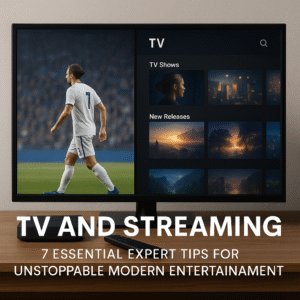TV and Streaming: 7 Essential Expert Tips for Unstoppable Modern Entertainment
The way we experience entertainment has transformed dramatically over the past two decades. From the days when families gathered around a bulky TV set with limited channels to today’s vast universe of digital choices, tv and streaming have redefined what it means to stay connected to culture, sports, and stories. Understanding how these two worlds work together—and sometimes compete—is essential for anyone navigating modern entertainment.
The Shift from Traditional TV to Streaming Platforms

According to industry reports from https://www.bbc.com, younger audiences are especially driving this change, often skipping traditional broadcasts altogether. Still, traditional television retains relevance in areas like live events and sports, where immediacy matters.
Why TV Still Matters in a Streaming-First World
It’s easy to declare streaming the winner, but traditional television continues to hold its ground. Live sports coverage from outlets like https://www.espn.com shows how TV maintains its dominance in certain categories. The reliability of broadcast systems is unmatched in high-stakes situations like international sports tournaments.
At the same time, many households use both—creating a hybrid model of tv and streaming. People may watch live matches on TV while turning to streaming for catching up on series or enjoying movies without borders.
The Rise of Smart Entertainment Devices
Smart TVs, digital media hubs, and connected devices have merged the old and new worlds of entertainment. Instead of choosing between tv and streaming, audiences can toggle seamlessly between the two. With a smart TV, switching from a live sports broadcast to a global access streaming app is effortless.
This integration of connected living has pushed brands to optimize user interfaces, reduce buffering, and expand international content availability. The best devices are turning into all-in-one digital media hubs that bridge the gap.
Global Access and Borderless Content
One of the biggest advantages of streaming is its ability to deliver international shows and movies. Audiences are no longer restricted to local programming; global entertainment has become standard. Platforms now compete to showcase worldwide shows, from K-dramas to Latin American series, that were once impossible to access outside their regions.
Websites like https://www.imdb.com have highlighted how international titles are climbing popularity charts. This democratization of access means that entertainment is no longer bound by geography.
Cost, Choice, and the Overwhelm Factor
Having thousands of titles at your fingertips sounds amazing—until you spend half an hour deciding what to watch. Streaming platforms are notorious for “choice overload,” a problem that never existed with traditional television. Interestingly, studies show people often revert to comfort content when overwhelmed, proving that unlimited access doesn’t always mean satisfaction.
For consumers, the challenge is finding balance. Services that combine curated TV schedules with streaming flexibility may represent the future of modern entertainment.
Case Study: Blending Both Worlds
At https://allsharemedia.com/our-prices/, viewers can explore how integrated services create smarter viewing experiences. Instead of forcing households to pick between formats, these solutions combine live television, on-demand libraries, and global access into one package.
Another example is found at https://allsharemedia.com/channel-list/, which demonstrates how worldwide shows and international sports can sit comfortably alongside traditional content. This hybrid approach is becoming more appealing to families seeking value and simplicity.
Expert Tips for Navigating TV and Streaming
-
Use smart entertainment devices for seamless switching.
-
Balance live TV with streaming to avoid missing real-time sports.
-
Explore global access platforms for international titles.
-
Check channel lists before subscribing to ensure variety.
-
Don’t overlook traditional TV for big events.
-
Leverage digital media hubs to centralize viewing.
-
Budget wisely—subscriptions add up quickly.
FAQ on TV and Streaming
Is traditional TV dying?
Not exactly. While streaming dominates, live events and sports keep TV relevant.
Why choose both TV and streaming?
The combination offers the reliability of broadcast with the flexibility of digital.
Are smart TVs necessary?
They’re not essential, but they make switching between content formats far easier.
What’s the biggest benefit of streaming?
Global access and borderless TV content that breaks down old limitations.

